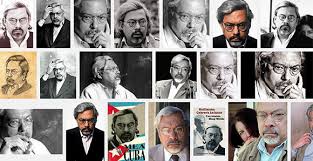GUILLERMO CABRERA INFANTE, NOVELISTA, ENSAYISTA, ESCRITOR, CRÍTICO. VIDEOS
Guillermo Cabrera Infante nació en Gibara, antigua provincia de Oriente (ahora parte de la provincia de Holguín) el 22 de abril de 1929. Fue novelista, ensayista, traductor, guionista y crítico cubano; en la década de 1950 utilizó El seudónimo G. Caín.
En 1941 se mudó con sus padres a La Habana, que sería el escenario de casi todos sus escritos además de sus obras críticas. Sus padres fueron miembros fundadores del Partido Comunista de Cuba.
Cabrera Infante, que alguna vez fue partidario del régimen de Castro, se exilió a Londres en 1965. Es mejor conocido por la novela ‘Tres Tristes Tigres’ (literalmente: “tres tigres tristes”, publicada en inglés como Tres tigres atrapados), que se ha comparado favorablemente con Ulises de James Joyce.
Originalmente tenía la intención de convertirse en médico, pero lo abandonó en favor de la escritura y su pasión por el cine. A partir de 1950, estudió periodismo en la Universidad de La Habana. Bajo el régimen de Batista, fue arrestado y multado en 1952 por publicar un cuento que incluía varias blasfemias en inglés. Su oposición a Batista luego le costó un corto período de cárcel.
Se casó por primera vez en 1953. De 1954 a 1960 escribió críticas de cine para la revista Carteles, utilizando el seudónimo G. Caín; se convirtió en su editor en jefe, aún con seudónimo, en 1957. Con el triunfo de la Revolución Cubana en 1959, fue nombrado director del Instituto del Cine. También fue jefe de la revista literaria Lunes de Revolución, un suplemento del periódico comunista Revolución; sin embargo, este suplemento fue prohibido en 1961 por Fidel Castro.
(1997)
Se divorció en 1961 y en el mismo año se casó con su segunda esposa, Miriam Gómez, una actriz. Habiendo caído un poco en desgracia con el régimen de Castro (la prohibición del gobierno de un documental sobre la vida nocturna en La Habana realizado por su hermano llevó a que se le prohibiera publicar en Cuba), sirvió de 1962 a 1965 en Bruselas, Bélgica, como agregado cultural. . Durante este tiempo, sus sentimientos se volvieron contra el régimen de Castro; Después de regresar a Cuba para el funeral de su madre en 1965, se exilió, primero en Madrid, luego en Londres.
En 1966 publicó Tres Tristes Tigres, una novela Joycean altamente experimental, lúdica y rica en alusiones literarias, que pretendía hacer por el español cubano lo que Mark Twain había hecho por el inglés americano, registrando la gran variedad de sus variaciones coloquiales. Ganó el Premio Biblioteca Breve de 1964 a la mejor novela inédita.
Co-escribió el guión de la película de culto de Richard C. Sarafian, Vanishing Point, de 1971, bajo el seudónimo de Guillermo Caín.
Aunque se lo considera parte de la famosa generación de escritores “Latin American Boom” que incluye a su contemporáneo Gabriel García Márquez, desdeñó la etiqueta. Siempre un iconoclasta, incluso rechazó la etiqueta de “novela” por sus obras maestras, como Tres Tristes Tigres y La Habana para un infante difunto. Fue influyente para escritores puertorriqueños y cubanos como Luis Rafael Sánchez (La guaracha del Macho Camacho) y Fernando Velázquez Medina (Última rumba en La Habana).
En 1997 recibió el Premio Cervantes, presentado por el rey Juan Carlos de España.
Murió el 21 de febrero de 2005, en Londres, de sepsis.
VIDA PERSONAL.
Esposa Marta Calvo (1953–1958)
Miriam Gómez (1961–2005)
Niños Ana (n. 1954), Carola (n. 1958)
BIBLIOGRAFÍA.
– Así en la paz como en la guerra (1960, “En paz como en la guerra”; un juego de palabras en una línea de la Oración del Señor), colección de cuentos
Twentieth Century Job (1963, publicado en español como “Un oficio del siglo XX”), colección de críticas cinematográficas
– Tres Tristes Tigres (1967, publicado en inglés como Three Trapped Tigers; el título original se refiere a un trabalenguas en español, y literalmente significa “Three Sad Tigers”; partes de esto se republicaron más tarde como Ella cantaba boleros), novela
– Vista del amanecer en el trópico (1974, publicado en inglés como “A View of Dawn in the Tropics”), novela
– O (1975), colección de cuentos / ensayos
– Exorcismos de esti (l) o (1976, “Exorcismos de estilo”; estilo significa estilo y estío, verano), colección de novelas / cuentos
– La Habana para un Infante Difunto (1979, publicado en inglés como Infante’s Inferno; el título en español es un juego de palabras sobre “Pavane pour une infante defunte”, título de una pieza para piano de Maurice Ravel), novela
– Holy Smoke (1985, en inglés, luego traducido al español como Puro Humo), una “historia” ficticia de cigarros
– Mea Cuba (1991, el título implica “Mi Cuba”, pero también significa “mea de Cuba” o “Cuba está meando” y es un juego de palabras con “Mea Culpa”), ensayos políticos.
– Arcadia todas las noches (1995, “Arcadia todas las noches”), ensayos
– Delito por bailar el chachachá (1995, en inglés: Guilty of Dancing the ChaChaCha, 2001, traducido por él mismo), colección de cuentos
– Ella Cantaba Boleros (1996, “She Sang Boleros”, consta de secciones tomadas de Tres Tristes Tigres), dos novelas
– Cine o sardina (1997, “Cine o sardina”, alude a la elección que le dio su madre entre comer e ir al cine), colección de artículos
– Vidas para leerlas (1998, “Vive para ser leído”), ensayos
– El Libro de las Ciudades (1999, “El libro de las ciudades”), colección de escritos
– Todo está hecho con espejos: Cuentos casi completos (1999, trans. “Todo está hecho con espejos: historias casi completas”), colección de cuentos
– Infantería (2000, título es un juego de palabras con su nombre y el español para “infantería”), colección de escritos
– La ninfa inconstante (2008, “La ninfa inconstante”, póstuma), novela
– Cuerpos divinos (2010, “Heavenly Bodies”, póstumo), novela autobiográfica
– Mapa dibujado por un espía (2013, “Mapa dibujado por un espía”, póstumo), novela
Cabrera Infante también tradujo los Dubliners de James Joyce al español (1972) y escribió guiones, incluyendo Vanishing Point y la adaptación de Under the Volcano de Malcolm Lowry.
GUILLERMO CABRERA INFANTE, NOVELIST, ESSAYIST, SCREENWRITER, CRITIC. VIDEOS.
Guillermo Cabrera Infante (Spanish pronunciation: [ɡiˈʎeɾmo kaˈβɾeɾa iɱˈfante]; was born in Gibara, former Oriente Province (now part of Holguín Province) on 22 April 1929. He was a Cuban novelist, essayist, translator, screenwriter, and critic; in the 1950s he used the pseudonym G. Caín.
In 1941 he moved with his parents, to Havana, which would be the setting of nearly all of his writings other than his critical works. His parents were founding members of the Cuban Communist Party.
A one-time supporter of the Castro regime, Cabrera Infante went into exile to London in 1965. He is best known for the novel ‘Tres Tristes Tigres’ (literally: “three sad tigers”, published in English as Three Trapped Tigers), which has been compared favorably to James Joyce’s Ulysses.
Originally he intended to become a physician but abandoned that in favor of writing and his passion for the cinema. Starting in 1950, he studied journalism at the University of Havana. Under the Batista regime, he was arrested and fined in 1952 for publishing a short story that included several English-language profanities. His opposition to Batista later cost him a short jail term.
He married for the first time in 1953. From 1954 to 1960 he wrote film reviews for the magazine Carteles, using the pseudonym G. Caín; he became its editor in chief, still pseudonymously, in 1957. With the triumph of the Cuban Revolution in 1959, he was named director of the Instituto del Cine. He was also head of the literary magazine Lunes de Revolución, a supplement to the Communist newspaper Revolución; however, this supplement was prohibited in 1961 by Fidel Castro.
He divorced in 1961 and in the same year married his second wife, Miriam Gomez, an actress. Having fallen somewhat out of favor with the Castro regime (the government’s ban on a documentary on Havana nightlife made by his brother led to his being forbidden to publish in Cuba), he served from 1962 to 1965 in Brussels, Belgium, as a cultural attaché. During this time, his sentiments turned against the Castro regime; after returning to Cuba for his mother’s funeral in 1965, he went into exile, first in Madrid, then in London.
In 1966 he published Tres Tristes Tigres, a highly experimental, Joycean novel, playful and rich in literary allusions, which intended to do for Cuban Spanish what Mark Twain had done for American English, recording the great variety of its colloquial variations. It won the 1964 Premio Biblioteca Breve for the best-unpublished novel.
He co-wrote the script for Richard C. Sarafian’s 1971 cult film Vanishing Point under the pseudonym Guillermo Caín.
Although he is considered a part of the famed “Latin American Boom” generation of writers that includes his contemporary Gabriel García Márquez, he disdained the label. Ever an iconoclast, he even rejected the label “novel” for his masterpieces, such as Tres Tristes Tigres and La Habana para un infante difunto. He was influential to Puerto Rican and Cuban writers such as Luis Rafael Sánchez (La guaracha del Macho Camacho) and Fernando Velázquez Medina (Última rumba en La Habana).
In 1997 he received the Premio Cervantes, presented to him by King Juan Carlos of Spain.
He died on February 21, 2005, in London, of sepsis.
PERSONAL LIFE.
Spouse Marta Calvo (1953–1958)
Miriam Gómez (1961–2005)
Children Ana (b. 1954), Carola (b. 1958)
BIBLIOGRAPHY.
– Así en la paz como en la guerra (1960, “In peace as in war”; a pun on a line from the Lord’s Prayer), short story collection
Twentieth Century Job (1963, published in Spanish as “Un oficio del siglo XX”), collection of film reviews
– Tres Tristes Tigres (1967, published in English as Three Trapped Tigers; the original title refers to a Spanish-language tongue-twister, and literally means “Three Sad Tigers”; portions of this were later republished as Ella cantaba boleros), novel
– Vista del amanecer en el trópico (1974, published in English as “A View of Dawn in the Tropics”), novel
– O (1975), short story / essay collection
– Exorcismos de esti(l)o (1976, “Exorcisms of style”; estilo means style and estío, summertime), novel/short story collection
– La Habana para un Infante Difunto (1979, published in English as Infante’s Inferno; the Spanish title is a pun on “Pavane pour une infante defunte”, title of a piano piece by Maurice Ravel), novel
– Holy Smoke (1985, in English, later translated into Spanish as Puro Humo), a fictionalized “history” of cigars
– Mea Cuba (1991, the title implies “My Cuba” but also means “Cuba Pisses” or “Cuba is Pissing” and is a pun on “Mea Culpa”), political essays.
– Arcadia todas las noches (1995, “Arcadia every night”), essays
– Delito por bailar el chachachá (1995, in English: Guilty of Dancing the ChaChaCha, 2001, translated by himself), short story collection
– Ella Cantaba Boleros (1996, “She Sang Boleros”, consists of sections taken from Tres Tristes Tigres), two novellas
– Cine o sardina (1997, “Cinema or sardine”, alludes to the choice his mother gave him between eating and going to the movies), collection of articles
– Vidas para leerlas (1998, “Lives to be read”), essays
– El Libro de las Ciudades (1999, “The Book of the Cities”), collection of writings
– Todo está hecho con espejos: Cuentos casi completos (1999, trans. “Everything is Made with Mirrors: Nearly Complete Stories”), short story collection
– Infantería (2000, title is a pun on his name and the Spanish for “infantry”), collection of writings
– La ninfa inconstante (2008, “The Inconstant Nymph”, posthumous), novel
– Cuerpos divinos (2010, “Heavenly Bodies”, posthumous), autobiographical novel
– Mapa dibujado por un espía (2013, “Map Drawn by a Spy”, posthumous), novel
Cabrera Infante also translated James Joyce’s Dubliners into Spanish (1972) and wrote screenplays, including Vanishing Point and the adaptation of Malcolm Lowry’s Under the Volcano.
Agencies/ Wiki/ Internet Photos/ YouTube/ Arnoldo Varona/ www.TheCubanHistory.com
THE CUBAN HISTORY, HOLLYWOOD.













